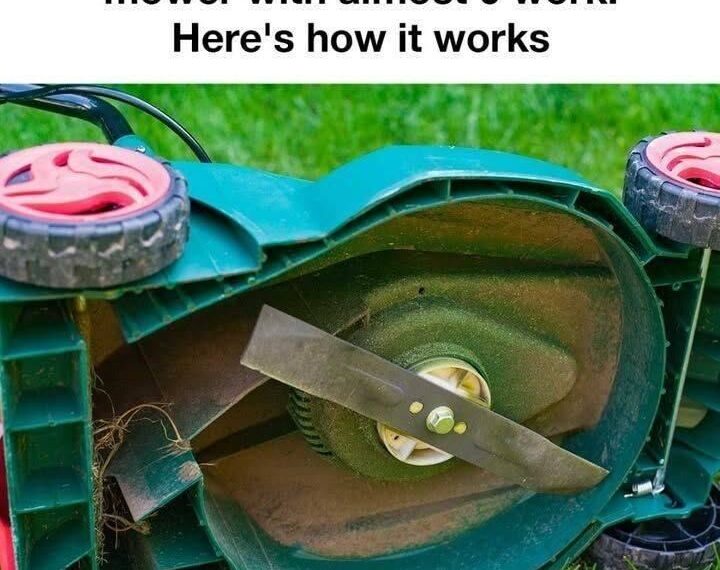Before the days of electric sharpeners and fancy tools, homeowners found clever, practical solutions to everyday problems using what they had at hand. My grandpa was a master of this ingenuity, passing down a straightforward blade sharpening method that requires minimal effort but yields professional-grade results.
This technique has stood the test of time because it’s:
- Simple
- Cost-effective
- Fast
- Requires no specialized skills or equipment
If you want to maintain your mower blades without a trip to the mechanic or spending on costly sharpening devices, this is your go-to hack.
Materials Needed for the Blade Sharpening Trick
Before you start, gather the following materials. Each is easy to find and affordable:
- Small strip of sandpaper (medium to fine grit, around 120–220 grit works well)
- WD-40 or another lubricant spray
- Socket wrench set appropriate for your mower’s blade bolts
- Wooden block (for stability during sharpening)
- Work gloves (to protect your hands)
That’s it! No fancy tools, no power equipment — just simple items most households have or can get easily.
Step-by-Step Guide to Sharpening Lawn Mower Blades Effortlessly
Step 1: Prepare Your Workspace and Equipment
Start by parking your lawn mower on a flat, stable surface. Make sure it is turned off and disconnected from any power source if it’s electric. For gas mowers, engage the safety lever to prevent accidental starts.
Step 2: Tip the Mower Safely
Tilt your mower onto its side so that the air filter and carburetor face upward. This prevents fuel or oil leaks during the process.
Step 3: Remove the Blade
Using your socket wrench, carefully loosen and remove the bolts holding the blade in place. Be sure to note the blade’s orientation for proper reinstallation later.
Step 4: Prepare Your Sandpaper
Spray a light coat of WD-40 onto the sandpaper. This helps reduce friction and allows the blade to glide smoothly across the abrasive surface.
Step 5: Sharpen the Blade
Place the sandpaper on the wooden block. Holding the blade firmly (wearing gloves!), run the sharp edge along the sandpaper in a single direction—avoid a back-and-forth motion, which can dull the blade. Continue until the blade’s edge feels keen and even. This usually takes a few passes.
Step 6: Reattach the Blade
Once you’re satisfied with the sharpness, securely bolt the blade back onto the mower, ensuring it is oriented correctly.
Step 7: Test Your Work
Set the mower upright and start it briefly to check that everything is running smoothly. You’ll likely notice an immediate improvement in cutting performance.
Safety Precautions and Important Tips
Safety can’t be stressed enough when working with sharp blades and power tools.
- Wear gloves throughout to protect your hands from cuts.
- Ensure the mower is completely off and disconnected before you start.
- Work slowly and deliberately to avoid slips or accidental injuries.
- Use a stable wooden block or surface to prevent the blade from moving while sharpening.
- Double-check the blade orientation during reinstallation — an incorrectly mounted blade can cause damage or injury.
Benefits of Keeping Lawnmower Blades Sharp
Sharpening your mower blades regularly offers a range of benefits:
- Better-looking lawns — cleaner cuts mean healthier grass.
- Improved mower efficiency — blades cut easier, reducing engine strain.
- Fuel savings — less effort from the engine means better fuel economy.
- Longer mower lifespan — less wear and tear on the engine and blade assembly.
- Time-saving — mowing goes faster with sharp blades cutting smoothly.
Alternative Methods of Blade Sharpening
While the sandpaper trick is quick and accessible, other options exist if you want a more professional finish or have different tools at hand.
1. Bench Grinder
- Ideal for those with access to a workshop.
- Offers fast sharpening but requires skill to maintain the correct blade angle.
- Can produce a sharper, more durable edge.
2. Sharpening Stones
- Traditional whetstones can be used by hand.
- More time-consuming but effective if you prefer manual methods without power tools.
3. Professional Services
- Lawn mower repair shops or hardware stores often offer sharpening services.
- Great if you’re not comfortable sharpening blades yourself.
- Usually costs a small fee but guarantees a precise job.
Common Mistakes to Avoid While Sharpening Blades
- Rushing the process: Sharpening too quickly or carelessly can lead to uneven edges or damage.
- Incorrect blade angle: Maintaining the blade’s original bevel angle is important for effective cutting.
- Not wearing gloves: Handling sharp metal without protection invites cuts.
- Forgetting safety precautions: Always disconnect power sources before working.
- Over-tightening or under-tightening blade bolts: Improper reattachment can cause vibration or accidents.
- Ignoring blade balance: An unbalanced blade can cause excessive wear on the mower. Consider balancing the blade after sharpening by placing it on a blade balancer or a nail to check for tilt.
Final Thoughts
Keeping your lawn mower blades sharp doesn’t have to be a dreaded chore or require professional tools. With just a bit of sandpaper, some lubricant, and a socket wrench, you can bring back the cutting power to your mower in just about 15 minutes.
Not only will your grass thank you with a healthier, neater appearance, but your mower will also perform better and last longer. And the best part? This is a simple trick handed down through generations, trusted by those who know that smart maintenance is the key to a beautiful lawn.
So next time you head out to mow, take a moment to sharpen those blades—you’ll be amazed at the difference.





